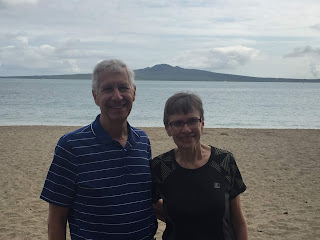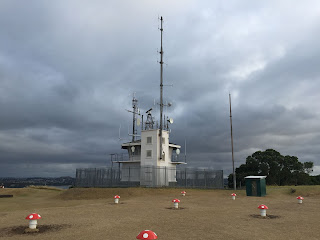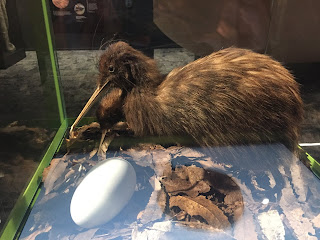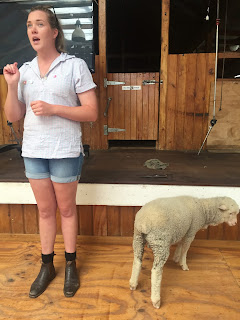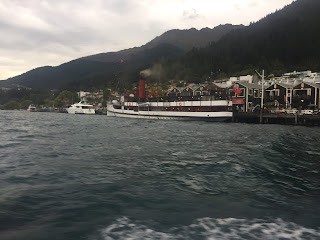The tour officially ended with the Farewell Dinner in Devonport last night. We had most of a day to kill in Auckland. We slept in, packed, took our time at breakfast, did some reading, then checked out of the hotel at the last possible moment, just before 10 a.m.
The hotel was happy to store our luggage for us. Then we struck out on a long walk, heading back to the “Domain” we had visited as a group by bus the day before. We had to navigate some very warm city streets with steep, up hill climbs. But we weren’t in any hurry.
It was only necessary to ask directions once, when we needed to find the pedestrian crossing over a motorway. Once in the Domain, we walked a nicely paved path, up another steep hill, and found ourselves right back at the Winter Garden once again.
For the return, we found a narrow little gravel trail along a creek in the rain forest. It was quite pretty, and difficult to believe that we were in the midst of a huge city where one third of New Zealand’s total population lives and works.
On the way back, we took a short-cut through the City Campus of Auckland University — one of the three public universities in New Zealand. Since tuition is so low for students from New Zealand, there are no private universities
We sat and rested a bit in Albert Park, not far from the life-sized statue of Queen Victoria. People watching was good there, and even a couple of people from our tour group happened by as we were sitting on our bench.
From the park, we did a very steep downhill (which is why we hadn’t gone that way on the outbound leg), and walked Victoria Street back across town to the hotel.
Even though we had to be out of our rooms by 10 a.m., the hotel provided us with a key card for access to the pool, as well as wi-fi access. After taking advantage of the lunch special down the block at The Shakespeare pub, we sat by the pool awhile. Then, just an hour or so before departure for the airport, we used the poolside shower rooms and, clean and refreshed, got into our clothes for the flight.
Our flight departed Auckland on time at 7:35 p.m. on Thursday evening. We landed in Houston, Texas at about 2 p.m. on Thursday afternoon. No, Air New Zealand aircraft are not capable of time travel. We crossed the international dateline, and gained back the day we had lost on the way to Fiji.
We had two seats to ourselves at the very back of the plane, with plenty of extra room around us for “stuff” so that the leg room was unobstructed. Both of us got several hours of sleep, but there was a lot of turbulence. It made for a bumpy ride, and they even delayed serving beverages a couple times due to the chop.
In Houston, we got through Immigration swiftly, walked a long way to our gate, and sat for two hours waiting. Then we suffered a last-minute gate change that made it necessary for us to take a very brisk 15 walk/train ride to a completely different terminal. Then, United Express had a mechanical issue with one of the overhead bin doors which the mechanic literally fixed with duct tape!
The delay was made up in the air, and the flight arrived on time. Arriving at MSP, where it was 55 degrees colder than the Auckland we had left, Katherine met us at the airport. We were home and in bed well before midnight.
The hotel was happy to store our luggage for us. Then we struck out on a long walk, heading back to the “Domain” we had visited as a group by bus the day before. We had to navigate some very warm city streets with steep, up hill climbs. But we weren’t in any hurry.
It was only necessary to ask directions once, when we needed to find the pedestrian crossing over a motorway. Once in the Domain, we walked a nicely paved path, up another steep hill, and found ourselves right back at the Winter Garden once again.
For the return, we found a narrow little gravel trail along a creek in the rain forest. It was quite pretty, and difficult to believe that we were in the midst of a huge city where one third of New Zealand’s total population lives and works.
On the way back, we took a short-cut through the City Campus of Auckland University — one of the three public universities in New Zealand. Since tuition is so low for students from New Zealand, there are no private universities
We sat and rested a bit in Albert Park, not far from the life-sized statue of Queen Victoria. People watching was good there, and even a couple of people from our tour group happened by as we were sitting on our bench.
From the park, we did a very steep downhill (which is why we hadn’t gone that way on the outbound leg), and walked Victoria Street back across town to the hotel.
Even though we had to be out of our rooms by 10 a.m., the hotel provided us with a key card for access to the pool, as well as wi-fi access. After taking advantage of the lunch special down the block at The Shakespeare pub, we sat by the pool awhile. Then, just an hour or so before departure for the airport, we used the poolside shower rooms and, clean and refreshed, got into our clothes for the flight.
Our flight departed Auckland on time at 7:35 p.m. on Thursday evening. We landed in Houston, Texas at about 2 p.m. on Thursday afternoon. No, Air New Zealand aircraft are not capable of time travel. We crossed the international dateline, and gained back the day we had lost on the way to Fiji.
We had two seats to ourselves at the very back of the plane, with plenty of extra room around us for “stuff” so that the leg room was unobstructed. Both of us got several hours of sleep, but there was a lot of turbulence. It made for a bumpy ride, and they even delayed serving beverages a couple times due to the chop.
In Houston, we got through Immigration swiftly, walked a long way to our gate, and sat for two hours waiting. Then we suffered a last-minute gate change that made it necessary for us to take a very brisk 15 walk/train ride to a completely different terminal. Then, United Express had a mechanical issue with one of the overhead bin doors which the mechanic literally fixed with duct tape!
The delay was made up in the air, and the flight arrived on time. Arriving at MSP, where it was 55 degrees colder than the Auckland we had left, Katherine met us at the airport. We were home and in bed well before midnight.






